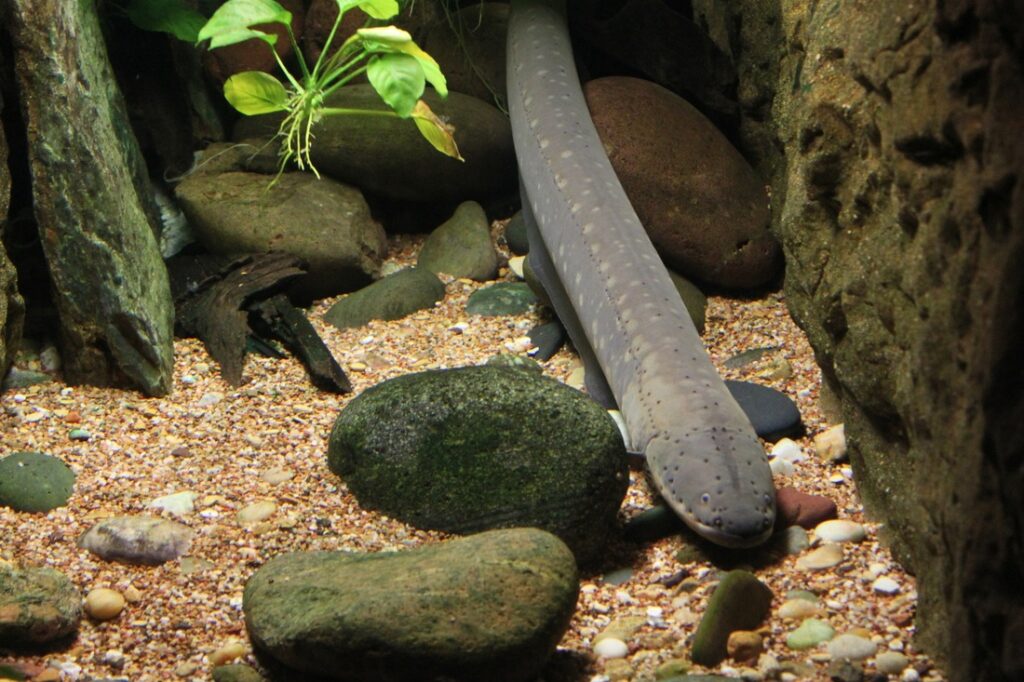An animal being able to produce electricity is both terrifying and fascinating. Electric eels can produce up to 600 volts of electricity. That’s more than enough to kill their prey and deter predators.

Specialized organs and cells make up the majority of an electric eel’s body. The rest of their vital organs sit crammed into about 20% of their body.
Even when the eels aren’t hunting, they are emitting small pulses of electricity. They have notoriously bad eyesight, so the pulses act as a navigation system.
What Are Electric Eels?
Electric eels consist of three species. There is the original electric eel (Electrophorus electricus). There is Vari’s electric eel (Electrophorus varri). Then, there is Volta’s electric eel (Electrophours voltai).
The electric eel has a slender body that resembles that of a snake. Their thick bodies have no scales and is smooth. The top of their body is dark gray to brown, while their underside is a dark yellowish-orange.
Like true eels, electric eels do not have pelvic fins. Unlike true eels, they don’t have dorsal fins, but they have a reduced caudal fin.
Instead of a dorsal fin, they have a long anal fin that stretches across the length of their body. The anal fin helps them to swim forwards and backward.
Electric eels can grow up to 6-8 ft (2-2.5 m) in length.
Air Breathers
The water in the electric eel’s habitat is oxygen-poor. But, they have evolved to thrive in these conditions.
They must breathe air from the surface, so they don’t have to rely on their gills for oxygen intake.
Their mouths have vascularized folds to increase surface area. Those folds allow the eels to use their mouth as a lung. The gills do not take in oxygen and are only used to rid the body of carbon dioxide.
Where Do Electric Eels Live?
These electrical fish are native to northern South America. They live most often in Brazil, the Guianas, Suriname, Venezuela, Columbia, Ecuador, and Peru.
They prefer ox-bow lakes, pools, streams, and flooded forests where the water is calm. They inhabit the side channels of the Amazon and Orinoco Rivers.
But, their habitats fluctuate throughout the season, so electric eels must be adaptable. The rainforests deal with dry and wet seasons which cause the water to ebb and rise.
During the dry season, the eels are often stuck in small streams and ponds. During the rainy season, the rivers rise, allowing lakes and ponds to reconnect.
Are Electric Eels Actually Eels?
We call them eels, and they look like eels, but they are not actually eels at all. They are more closely related to catfish and carp than they are to true eels.
The National Aquarium states that:
“Though commonly referred to as an eel, this fish is not considered a “true” eel. While true eels are classified in the order Anguilliformes, the electric eel is actually in the order Gymnotiformes, the knife fishes. Knife fishes have no dorsal fin and a long, extended anal fin.”
What Does Electric Eel Eat?
Electric eels are carnivores who will eat just about anything they can get a hold of. Their diet consists of fish, crustaceans, insects, reptiles, amphibians, and even small mammals.
How Do Eels Produce Electricity?

Electric eels have three specialized organs that produce electricity. There is the main electrical organ, Hunter’s organ, and Sachs’ organ. These electrical organs take up about 80% of the space in the fish’s body. The rest of its vital organs sit close to the front of the body.
The main electrical organ sits on the dorsal side of the fish’s body. It covers the middle half of the body from behind the head to the middle of the tail.
The Hunter’s organ sits parallel to the main organ on the ventral side. The Sach’s organ sits at the rear of the fish’s body, taking up about a quarter of its body length.
The main electrical organ and ⅔ of the Hunter’s organ produce the most powerful shocks. The remaining ⅓ of the Hunter’s and the Shach’s organs produce weaker shocks.
The electrical organs contain about 6,000 electrocytes. Electrocytes are specialized cells that store power. An electric eel discharges electricity by firing all these electrocytes at once.
These fish can produce a lot of electricity, but they won’t always use their full power. They can use as little or as much as they think is necessary. The more power they produce, the more energy drains from their body. So, it’s in their best interest to use only as much electricity as they need.
The electrical shocks act as a defense mechanism against predators. They also use it to stun prey when hunting.
How Do Electric Eels Shock?
During the dry season, electric eels are often isolated in small pools and streams. It can be difficult or impossible to escape predators in these small bodies of water. So, the fish must use their electricity as a defense mechanism.
Electricity As A Defense Mechanism
Water is an excellent conductor of electricity. But, the large surface area of water dulls the electrical shock. So, an electric eel is less likely to harm a predator if it shocks it while in the water.
To cause more damage, an eel may jump out of the water to press its body against the predator. Outside of the water, an electric eel’s shock is more powerful.
As they shock their target, the fish start with a lower voltage. This allows them to see which voltage is effective without draining their energy. If a lower voltage isn’t enough, they will slowly increase the voltage.
Electricity For Hunting

The way they use their electricity to hunt is a bit different than when they use it for defense. Their habitat generally consists of muddy and murky water. Visibility is nearly non-existent. So, they use their electricity to sense any prey that may be around them.
The electrical pulses act like a navigation tool. While swimming around, these pulses rarely exceed 10 volts.
The Smithsonian National Zoo & Conservation Biology Institute states that:
“In the dark and murky waters they inhabit, prey can be difficult to spot. To aid its hunt, the electric eel has motion-sensitive hairs along its body (the lateral line system) that detect any slight pressure change in the surrounding water. When the eel suspects a prey item is nearby, it emits two rapid electric pulses, called a doublet.
This doublet affects the muscles of the prey, causing it to twitch involuntarily and alerting the electric eel to its presence. With a series of high-voltage pulses (as many as 400 per second), it then paralyzes and consumes its prey. This entire process happens so quickly that it can be difficult for the human eye to observe in detail.”
Sometimes, electric eels will wrap their bodies around the body of their prey. This is often reserved for large or fast prey. Wrapping themselves around their prey nearly doubles the strength of the electricity.
Most electric eels hunt alone, but Volta’s electric eel will hunt in packs. Several eels work together to time their movements and shocks to ambush fish.
How Many Volts Do Electric Eels Produce?
An electric eel is so powerful that it can produce up to 600 volts of energy.
The electricity produced by electric eels is rarely enough to kill a human. But, if the fish shocks a person many times in a row, it can cause respiratory or heart failure. People have also drowned after a strong shock prevented them from raising their head above the water.
Electric Eels Use Electricity To Communicate
Electric eels also use pulses to communicate with one another.
They produce low pulses of electricity to share information with each other. Often, these messages pertain to breeding.
Conclusion
Electric eels are unlikely to kill a human. Still, the amount of electricity they produce can be debilitating. Their powerful shocks are enough to take down prey and large predators. It’s even useful for navigating the murky waters of the Amazon River.
In some areas, it’s legal to keep electric eels as pets. So, if you ever come across one, think twice about putting your hand in the water with them.
FAQs
Electric eels do not have teeth, so they can’t tear or chew their prey. Instead, they pull their prey into their mouths with a strong suction. Then, they swallow them whole.
People have known about electric eels long before the discovery of electricity. So, what did people call the electric eel centuries ago, and what did they think of its abilities?
The electric eel only received its scientific name (Electrophorus electricus) 250 years ago. Before that, indigenous people in Venezuela referred to it as “arimna”. Arimna translates to “something that deprives you of motion”.
